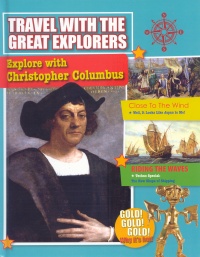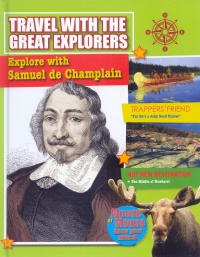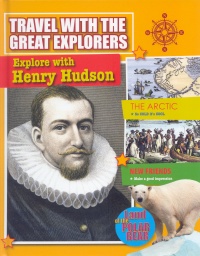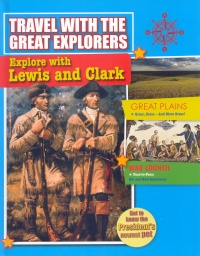| ________________
CM . . .
. Volume XX Number 34. . . .May 2, 2014
excerpt:
The “Travel with the Great Explorers” series records the lives of four of the most significant explorers of North America. Their journeys over the Atlantic and Arctic Ocean, down the rivers and across the plains and mountains broke the trail for further expansion of European (and American, in the case of Lewis and Clarke) settlement, displacement and disenfranchisement of the First Nations, and exploitation of the resources there. Each book in the series is 32 pages long and divided into two-page chapters with headings listed in a Table of Contents. The information is indexed alphabetically at the end of the book. A glossary defines bolded words, and further research on websites and in books is suggested. In general, the books provide a comprehensive understanding of the lives of each explorer. The pages are colourful, and each chapter is uniquely designed, with framed photos, paintings, drawings or maps. Chapter titles have contemporary wording to appeal to young readers: “Where Are We Heading?”, “Hanging at Home” and “This Isn’t What It Said in the Brochure” among them. Facts are discussed in one-paragraph sections, each with an attention-grabbing headline, such as Changing Direction, with bulleted subheadings *Compass points the way! and *That’s not the North (Explore with Christopher Columbus). The paragraphs contain information that is clearly explained. The content includes chapters about the explorer’s encounters with the various First Nations, how the explorers collected scientific data and what they learned from the natural world they explored – the climate, plants, geography, the animals they sought and the animals they encountered.
The Corps of Discovery was often surrounded by herds of buffalo, elk, and deer. But Lewis wrote in his journal that “altho’ game is very abundant and gentle, we only kill as much as is necessary for food.” Eating too much meat upset the stomach of many of the men. Sacagawea picked edible wild plants to improve their diets. (Explore with Lewis and Clark.) A young researcher could learn much from these books but for the way the template for the series is set up. The information is not chronological, and so a child would be required to go back and forth through the books to trace the explorers’ lives from beginning to end and to understand fully the issues created by their voyages. For example, in the paragraph quoted at the top of this review, found on page 4 of Explore with Samuel de Champlain, readers learn that Champlain travelled with Sieur de Mons. But it’s not until page 10 that readers learn Sieur de Mons was granted a fur trade monopoly in 1603 and that he was the individual delegated to found the colonies and convert the Aboriginal people. He was even more pivotal to the enterprise than was Champlain. Similarly, readers learn about the unhappy ending of Henry Hudson’s last voyage on page 11 of Explore with Henry Hudson, but they only learn about how his poor managerial skills fostered a mutiny on page 26. More examples abound. There is much to recommend about the content and design of these books. But a simple reshuffling of the sections (not at all difficult in these days of computer layouts) would make them much more sensible for a school library and, most importantly, useful for students. Imaginative chapter titles need not be lost; they simply need to be redefined. Recommended. Harriet Zaidman is a teacher-librarian in Winnipeg, MB.
To comment
on this title or this review, send mail to cm@umanitoba.ca.
Copyright © the Manitoba Library Association. Reproduction for personal
use is permitted only if this copyright notice is maintained. Any
other reproduction is prohibited without permission.
NEXT REVIEW |
TABLE OF CONTENTS FOR THIS ISSUE
- May 2, 2014.
AUTHORS |
TITLES |
MEDIA REVIEWS |
PROFILES |
BACK ISSUES |
SEARCH |
CMARCHIVE |
HOME |



